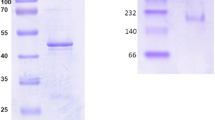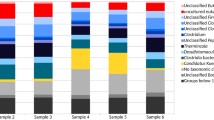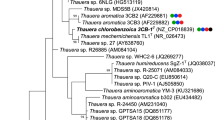Abstract. Genes involved in anaerobic degradation of the petroleum hydrocarbon ethylbenzene in the denitrifying Azoarcus-like strain EbN1 were identified on a 56-kb DNA contig obtained from shotgun sequencing. Ethylbenzene is first oxidized via ethylbenzene dehydrogenase to (S)-1-phenylethanol; this is converted by (S)-1-phenylethanol dehydrogenase to acetophenone. Further degradation probably involves acetophenone carboxylase forming benzoylacetate, a ligase forming benzoylacetyl-CoA, and a thiolase forming acetyl-CoA and benzoyl-CoA. Genes of this pathway were identified via N-terminal sequences of proteins isolated from strain EbN1 and by sequence similarities to proteins from other bacteria. Ethylbenzene dehydrogenase is encoded by three genes (ebdABC), in accordance with the heterotrimeric enzyme structure. Binding domains for a molybdenum cofactor (in subunit EbdA) and iron/sulfur-clusters (in subunits EbdA and EbdB) were identified. The previously observed periplasmic location of the enzyme was corroborated by the presence of a twin-arginine leader peptide characteristic of the Tat system for protein export. A fourth gene (ebdD) was identified, the product of which may act as an enzyme-specific chaperone in the maturation of the molybdenum-containing subunit. A distinct gene (ped) coding for (S)-1-phenylethanol dehydrogenase apparently forms an operon with the ebdABCD genes. The ped gene product with its characteristic NAD(P)-binding motif in the N-terminal domain belongs to the short-chain dehydrogenase/reductase (SDR) superfamily. A further operon apparently contains five genes (apc1–5) suggested to code for subunits of acetophenone carboxylase. Four of the five gene products are similar to subunits of acetone carboxylase from Xanthobacter autotrophicus. Upstream of the apc genes, a single gene (bal) was identified which possibly codes for a benzoylacetate CoA-ligase and which is co-transcribed with the apc genes. In addition, an apparent operon containing almost all genes required for β-oxidation of fatty acids was detected; one of the gene products may be involved in thiolytic cleavage of benzoylacetyl-CoA. The DNA fragment also included genes for regulatory systems; these were two sets of two-component systems, two LysR homologs, and a TetR homolog. Some of these proteins may be involved in ethylbenzene-dependent gene expression.
Similar content being viewed by others
Author information
Authors and Affiliations
Additional information
Electronic Publication
Rights and permissions
About this article
Cite this article
Rabus, R., Kube, M., Beck, A. et al. Genes involved in the anaerobic degradation of ethylbenzene in a denitrifying bacterium, strain EbN1. Arch Microbiol 178, 506–516 (2002). https://doi.org/10.1007/s00203-002-0487-2
Received:
Revised:
Accepted:
Issue Date:
DOI: https://doi.org/10.1007/s00203-002-0487-2




